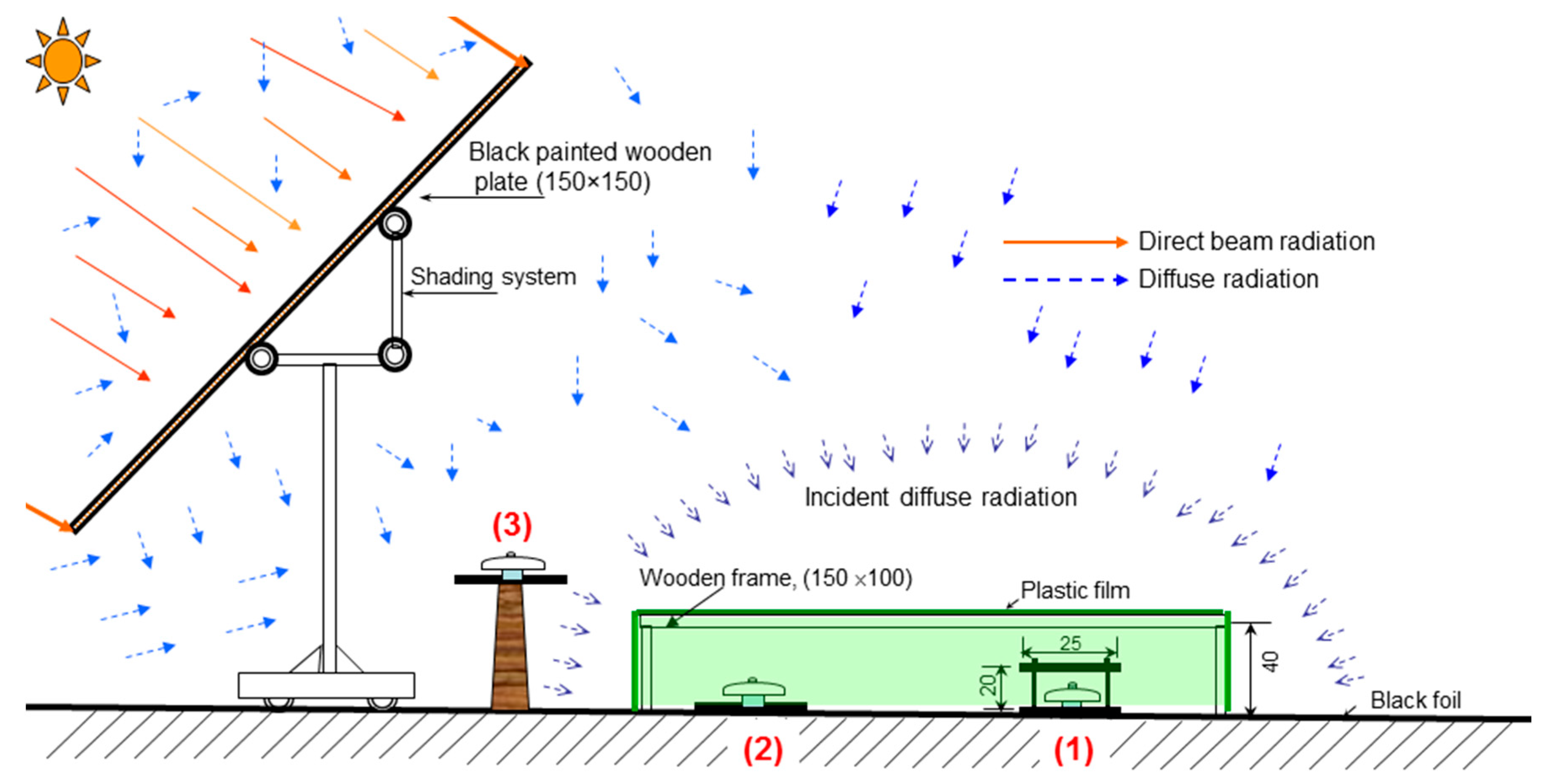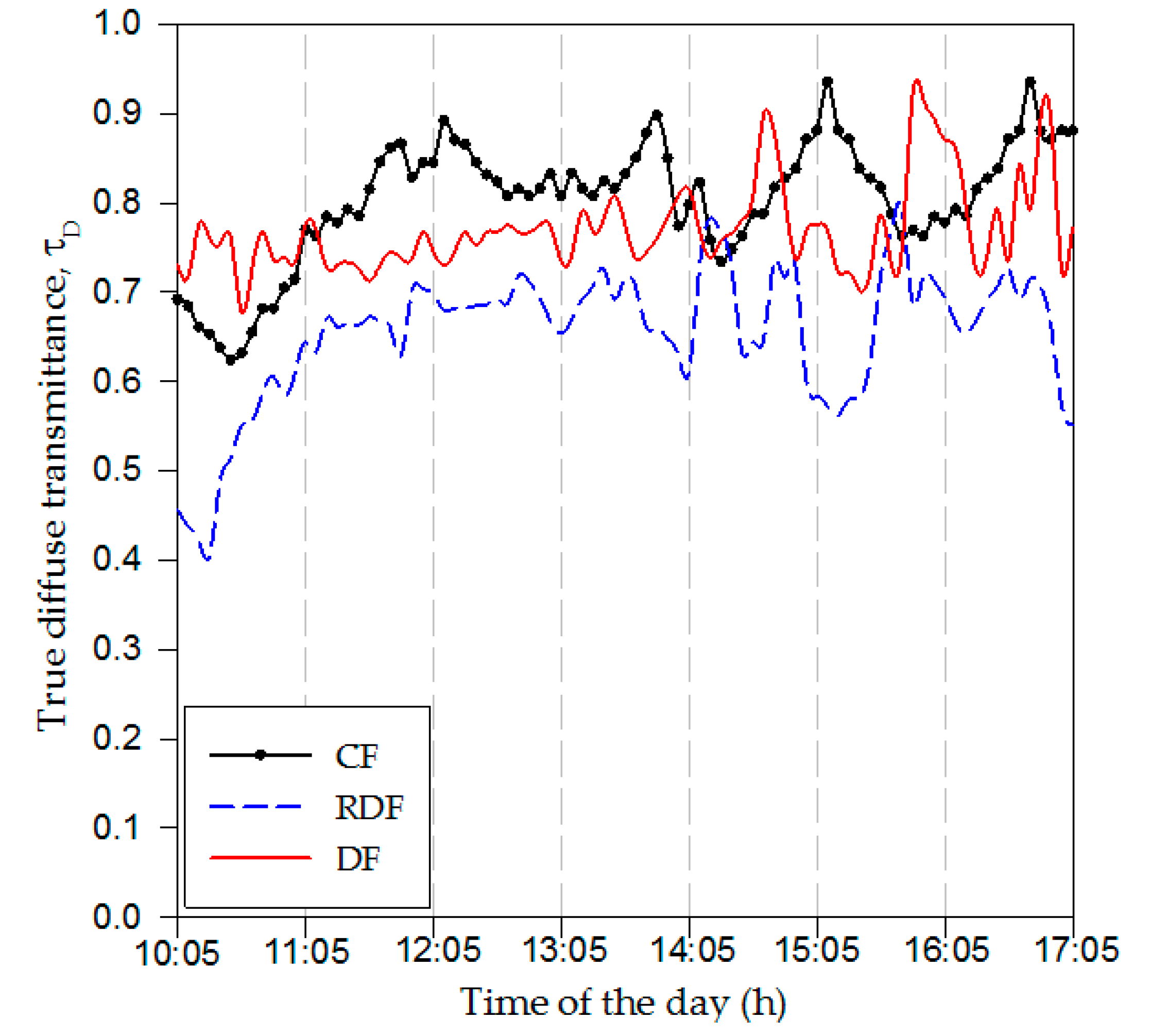Diffusion Characteristics of Solar Beams Radiation Transmitting through Greenhouse Covers in Arid Climates
Abstract
:1. Introduction
2. Materials and Methods
2.1. Theoretical Analysis
2.2. The Three Films Tested
2.3. Experimental Procedures and Measurements
2.3.1. Experiment in the Three Greenhouse Models
2.3.2. Experiment to Examine the Effect of Tilting on the Shaded Pyranometer Readings
2.3.3. Experiment for Determining the Correction Factors of the Shaded Pyranometers
3. Results and Discussion
3.1. Diffusion Characteristics of the Tested Films
3.2. The Microclimate under the Three Covers
4. Conclusions and Recommendation
- The three films tested (i.e., CF, DF, and RDF) were able to diffuse the solar beams radiation transmitted through them; they diffused 43%, 34%, and 33% of the transmitted beam radiation, respectively, during transmission. The three covers increased the diffuse to direct beam radiation ratio from 0.3 outside the greenhouse models to 0.95, 0.77, and 0.69 under the CF, DF, and RDF covers, respectively.
- Even though the reflectance of the RDF cover is 5%–6% higher than the CF and DF covers, it shows a similar effect on the inside greenhouse air temperature as the DF cover; however, the CF cover decreased the inside air temperature by about 5–10 °C (at around noon) and increased the relative humidity by 4%–5% compared to those under the DF, and DRF covers.
- During nighttime, the three film covers show nearly the same effects on the air temperature and relative humidity inside the greenhouse models.
- The CF cover shows a better performance in terms of diffusion and improving the microclimate inside the greenhouse model and this improvement is expected to increase with the increase in the greenhouse volume (i.e., large-scale and commercial greenhouses); this film cover can be used effectively in arid climates.
- It is quite difficult to conclude the financial impact of using the CF cover because its low price is allocated with the relatively low service life of the film (Table 1).
Author Contributions
Funding
Acknowledgments
Conflicts of Interest
Nomenclature
| Bi | direct beam solar radiation incident on the cover film (W m−2) |
| Bt | direct beam radiation transmitted through the cover film (W m−2) |
| Bu | unscattered beam radiation transmitted into the greenhouse (W m−2) |
| CF | locally produced film was used as control |
| D/B | ratio of diffuse to direct beam radiation inside or outside the greenhouse |
| DF | diffusive film cover |
| Di | atmospheric diffuse radiation incident on the greenhouse cover (W m−2) |
| Dt | atmospheric diffuse radiation transmitted through the cover (W m−2) |
| Dtot | total diffuse radiation flux measured inside the greenhouse (W m−2) |
| Dtot-1 | total diffuse radiation flux measured by pyranometer (1) under a film (W m−2) |
| Dtot-2 | total diffuse radiation flux measured by pyranometer (2) under a film (W m−2) |
| E | diffuse radiation enhancement inside the greenhouse (%) |
| Fc | correction factor of a shaded pyranometer (-) |
| Fc-o | correction factor of a shaded pyranometer outside the greenhouse (-) |
| Fc-CF | correction factor of a shaded pyranometer under the CF cover (-) |
| Fc-DF | correction factor of a shaded pyranometer under the DF cover (-) |
| Fc-RDF | correction factor of a shaded pyranometer under the RDF cover (-) |
| PAR | the photosynthetically active radiation (400–700 nm) (W m−2) |
| RDF | reflective-diffusive film cover |
| RHi | relative humidity of the air inside the greenhouse model |
| RHo | relative humidity of the air outside the greenhouse model |
| Si | global solar radiation flux incident on the greenhouse cover (W m−2) |
| St | global solar radiation flux transmitted through the cover film (W m−2) |
| Ti | air temperature inside the greenhouse model (°C) |
| To | air temperature outside the greenhouse model (°C) |
| total reflectance of the cover film to global solar radiation (%) | |
| σ | diffusion coefficient (-) |
| true transmittance of the cover film to diffuse radiation | |
| apparent transmittance of the cover film to diffuse radiation | |
| total transmittance of the cover film to global solar radiation | |
| total transmittance of the cover film to PAR (-) | |
| total transmittance of the cover film to NIR (-) |
References
- Ghani, S.; El-Bialy, E.M.A.A.; Bakochristou, F.; Rashwan, M.M.; Abdelhalim, A.M.; Ismail, S.M.; Ben, P. Experimental and numerical investigation of the thermal performance of evaporative cooled greenhouses in hot and arid climates. Sci. Technol. Built Environ. 2019, 1–20. [Google Scholar] [CrossRef] [Green Version]
- Hesham, A.A.; Tong, Y.X.; Yang, Q.C.; Al-Faraj, A.A.; Abdel-Ghany, A.M. Spatial distribution of air temperature and relative humidity in the greenhouse as affected by external shading in arid climates. J. Integr. Agric. 2019, 18, 2869–2882. [Google Scholar]
- Al-Helal, I.A. Effects of ventilation rate on the environment of a fan-pad evaporatively cooled, shaded greenhouse in extreme arid climates. Appl. Eng. Agric. 2007, 23, 221–230. [Google Scholar] [CrossRef]
- Semar, A.; Hartani, T.; Bachir, H. Soil and water salinity evaluation in new agriculture land under arid climate, the case of the Hassi Miloud area, Algeria. Euro-Mediterr. J. Environ. Integr. 2019, 4, 40. [Google Scholar] [CrossRef]
- Abdel-Ghany, A.M.; Al-Helal, I.M.; El-zahrani, S.M.; Alsadon, A.A.; Ali, I.M.; Elleithy, R.M. Covering materials incorporating radiation-preventing techniques to meet greenhouse cooling challenges in arid regions: A review. Sci. World J. TSWJ 2012. [Google Scholar] [CrossRef]
- Sethi, V.P.; Sharma, S.K. Survey of cooling technologies for worldwide agricultural greenhouse applications. Sol. Energy 2007, 81, 447–1459. [Google Scholar] [CrossRef]
- Syed, K.H.G.; Abdel-Ghany, A.M.; Al-Helal, I.M.; El-zahrani, S.M.; Alsadon, A.A. Evaluation of PE film having NIR-reflective additives for greenhouse applications. Adv. Mater. Sci. Eng. 2013, 2013, 575081. [Google Scholar] [CrossRef] [Green Version]
- Verlodt, I.; Verschaeren, P. New interference film for climate control. Acta Hortic. 2000, 514, 139–146. [Google Scholar] [CrossRef]
- Hemming, S.; Swinkels, G.L.A.M.; van Breugel, A.J.; Mohammadkhani, V. Evaluation of diffusing properties of greenhouse covering materials. Acta Hortic. 2016, 1134, 309–316. [Google Scholar] [CrossRef]
- Hemming, S.; Mohammadkhani, V.; van Ruijven, J. Material technology of diffuse greenhouse covering materials-Influence on light transmission, light scattering and light spectrum. Acta Hortic. 2014, 1037, 883–895. [Google Scholar] [CrossRef]
- Dueck, T.; Janse, J.; Li, T.; Kempkes, F.; Eveleens, B. Influence of diffuse glass on the growth and production of tomato. Acta Hortic. 2012, 956, 75–82. [Google Scholar] [CrossRef] [Green Version]
- Markvart, J.; Rosenqvist, E.; Aaslyng, J.M.; Ottosen, C.O. How is canopy photosynthesis and growth of chrysanthemums affected by diffuse and direct light? Eur. J. Hortic. Sci. 2010, 75, 253–258. [Google Scholar]
- Tavares, C.; Goncalves, A.; Castro, P.; Loureiro, D.; Joyce, A. Modeling an agriculture production greenhouse. Renew. Energy 2001, 22, 15–20. [Google Scholar] [CrossRef]
- Papadakis, G.; Manolakos, D.; Kyritsis, S. Solar radiation transmissivity of a single-span greenhouse through measurements on scale models. J. Agric. Eng. Res. 1998, 71, 331–338. [Google Scholar] [CrossRef]
- Balocco, C.; Mercatelli, L.; Azzali, N.; Meucci, M.; Grazzini, G. Experimental transmittance of polyethylene films in the solar and infrared wavelengths. Sol. Energy 2018, 165, 199–205. [Google Scholar] [CrossRef]
- Graefe, J.; Sandmann, M. Shortwave radiation transfer through a plant canopy covered by single and double layers of plastic. Agric. Forest Meteorol. 2015, 201, 196–208. [Google Scholar] [CrossRef] [Green Version]
- Aldaftari, H.A.; Okajima, J.; Komiya, A.; Maruyama, S. Radiative control through greenhouse covering materials using pigmented coatings. J. Quant. Spectrosc. Radiat. Trans. 2019, 231, 29–36. [Google Scholar] [CrossRef]
- Mobtaker, H.G.; Ajabshirchi, Y.; Ranjbar, S.F. Simulation of thermal performance of solar greenhouse in north-west of Iran: An experimental validation. Renew. Energy 2019, 135, 88–97. [Google Scholar] [CrossRef]
- Emekli, N.Y.; Buyuktas, K.; Bascetincelik, A. Changes of light transmittance of the LDPE films during the service life for greenhouse application. J. Build. Eng. 2016, 6, 126–132. [Google Scholar] [CrossRef]
- Xie, X.; Liu, Y.-J.; Hao, J.-J.; Ju, L.; Du, W.-C.; Yang, H.-W. Feasibility study of a new solar greenhouse covering material. J. Quant. Spectrosc. Radiat. Trans. 2019, 224, 37–43. [Google Scholar] [CrossRef]
- Pollet, I.V.; Pieters, J.G.; Deltour, J.; Verschoore, R. Diffusion of radiation transmitted through dry and condensate covered transmitting materials. Sol. Energy Mater. Sol. Cells 2005, 86, 177–196. [Google Scholar] [CrossRef]
- Abdel-Ghany, A.M.; Al-Helal, I.M. Characterization of solar radiation transmission through plastic shading nets. Sol. Energy Mater. Sol. Cells 2010, 94, 1371–1378. [Google Scholar] [CrossRef]
- Burek, S.A.M.; Norton, B.; Probert, S.D. Transmission and forward scattering of insolation through plastic (transparent and semi-transparent) materials. Sol. Energy 1989, 42, 457–475. [Google Scholar] [CrossRef]
- Garcia-Alonso, Y.; Espi, E.; Salmeron, A.; Fontecha, A.; Gonzalez, A.; Lopez-Marin, J. New cool plastic films for greenhouse covering in tropical and subtropical areas. Acta Hortic. 2006, 719, 131–137. [Google Scholar] [CrossRef]
- Lopez-Marin, J.; Gonzalez, A.; Garcia-Alonso, Y.; Espi, E.; Salmeron, A.; Fontecha, A.; Real, A.I. Use of cool plastic films for greenhouse covering in Southern Spain. Acta Hortic. 2008, 801, 181–186. [Google Scholar] [CrossRef]
- Hemming, S.; Kempkes, F.; van der Braak, N.; Dueck, T.; Marissen, N. Greenhouse cooling by NIR-reflection. Acta Hortic. 2006, 719, 97–105. [Google Scholar] [CrossRef] [Green Version]
- Abdel-Ghany, A.M. Solar energy conversions in the greenhouses. Sustain. Cities Soc. 2011, 1, 219–226. [Google Scholar] [CrossRef]











| Properties Supplied by the Producers | PE-EVA, Diffusive Film (DF) | PE-LLDEP, Reflective Diffusive Film, (RDF) | PE-LD, Locally Produced Film (CF) |
|---|---|---|---|
| Film thickness (µm) | 180 | 200 | 200 |
| Diffusion (%) | 60 | 40 | - |
| PAR transmittance, (%) | 87–88 | 78–80 | 75–80 |
| NIR transmittance, (%) | <17 | - | - |
| Working temperature (°C) | - | - | 50–80 |
| Service life (year) | 4–5 | 4–5 | 2–3 |
| Local price (US $/m2) | 0.73 | 0.73 | 0.41 |
| Film Cover | σ (%) | E (%) | ||||||
|---|---|---|---|---|---|---|---|---|
| DF | 39.8 | 57.4 | 51.0 | 12.5 | 76.0 | 133 | 34 | 77 |
| RDF | 45.0 | 47.8 | 44.2 | 18.5 | 65.0 | 122 | 33 | 85 |
| CF | 46.2 | 59.0 | 53.5 | 13.5 | 77.0 | 162 | 43 | 109 |
© 2020 by the authors. Licensee MDPI, Basel, Switzerland. This article is an open access article distributed under the terms and conditions of the Creative Commons Attribution (CC BY) license (http://creativecommons.org/licenses/by/4.0/).
Share and Cite
Al-Helal, I.; Alsadon, A.; Shady, M.; Ibrahim, A.; Abdel-Ghany, A. Diffusion Characteristics of Solar Beams Radiation Transmitting through Greenhouse Covers in Arid Climates. Energies 2020, 13, 472. https://doi.org/10.3390/en13020472
Al-Helal I, Alsadon A, Shady M, Ibrahim A, Abdel-Ghany A. Diffusion Characteristics of Solar Beams Radiation Transmitting through Greenhouse Covers in Arid Climates. Energies. 2020; 13(2):472. https://doi.org/10.3390/en13020472
Chicago/Turabian StyleAl-Helal, Ibrahim, Abdullah Alsadon, Mohamed Shady, Abdullah Ibrahim, and Ahmed Abdel-Ghany. 2020. "Diffusion Characteristics of Solar Beams Radiation Transmitting through Greenhouse Covers in Arid Climates" Energies 13, no. 2: 472. https://doi.org/10.3390/en13020472





